Submitted:
20 June 2024
Posted:
21 June 2024
You are already at the latest version
Abstract
Keywords:
1. Introduction
2. Materials and Methods
2.1. Chromatic Critical Flicker Fusion Frequency Device
2.2. Ocular Wavefront
2.3. Photostress Recovery Time
2.4. Chromatic Critical Flicker Fusion Frequency
2.5. Participants and experimental protocol
2.6. Statistical Analysis
3. Results
3.1. Chromatic Critical Flicker Fusion Frequency
3.2. cCFF and Photostress Recovery Time
3.3. Influence of the optical quality of the eye on cCFF
4. Discussion and Conclusions
Funding
Institutional Review Board Statement
Informed Consent Statement
Data Availability Statement
Conflicts of Interest
References
- Z. E. Snow. Visual Acuity as a Measurement of Visual Function. Methods Mol. Biol. 2023, 2560, 141–144. [Google Scholar]
- Bennett, C.R.; Bex, P.J.; Bauer, C.M.; Merabet, L.B. The Assessment of Visual Function and Functional Vision. Semin. Pediatr. Neurol. 2019, 31, 30–40. [Google Scholar] [CrossRef] [PubMed]
- P. Lennie. “The physiological basis of variations in visual latency. Vis. Res. 1981, 21, 815–824. [Google Scholar] [CrossRef]
- M. Coltheart. “The persistences of vision”. Philos. Trans. R. Soc. Lond. B. Biol. Sci. 1980, 290, 57–69. [Google Scholar] [CrossRef] [PubMed]
- Wutz, A.; Muschter, E.; van Koningsbruggen, M.G.; Weisz, N.; Melcher, D. Temporal Integration Windows in Neural Processing and Perception Aligned to Saccadic Eye Movements. Curr. Biol. 2016, 26, 1659–1668. [Google Scholar] [CrossRef] [PubMed]
- Borghuis, B.G.; Tadin, D.; Lankheet, M.J.; Lappin, J.S.; van de Grind, W.A. Temporal Limits of Visual Motion Processing: Psychophysics and Neurophysiology. Vision 2019, 3, 5. [Google Scholar] [CrossRef] [PubMed]
- A. Bowling, W. Lovegrove. Two components to visible persistence: Effects of orientation and contrast Vis. Res. 1981, 21, 1241–1251.
- Yeonan-Kim, J.; Francis, G. Retinal spatiotemporal dynamics on emergence of visual persistence and afterimages. Psychol. Rev. 2019, 126, 374–394. [Google Scholar] [CrossRef] [PubMed]
- Gibbon, J.; Malapani, C.; Dale, C.L.; Gallistel, C. Toward a neurobiology of temporal cognition: advances and challenges. Curr. Opin. Neurobiol. 1997, 7, 170–184. [Google Scholar] [CrossRef] [PubMed]
- Melcher, D.; Wutz, A.; Drewes, J.; Fairhall, S. The Role of Temporal Integration Windows in Visual Perception. Procedia - Soc. Behav. Sci. 2014, 126, 92–93. [Google Scholar] [CrossRef]
- Chokron, S.; Kovarski, K.; Dutton, G.N. Cortical Visual Impairments and Learning Disabilities. Front. Hum. Neurosci. 2021, 15. [Google Scholar] [CrossRef] [PubMed]
- T. Muth, J.D. Schipke, A.K. Brebeck, S. Dreyer. Assessing Critical Flicker Fusion Frequency: Which Confounders? A Narrative Review. Medicina (Kaunas), 2023, 59, 800.
- R. S. Brenton, H.S. R. S. Brenton, H.S. Thompson, C. Maxner. Critical flicker frequency: a new look at an old test [internet]. In: New Methods of Sensory Visual Testing. New York: Springer; 1989, 29–52.
- R.S. Brenton, H.S. R.S. Brenton, H.S. Thompson, C. Maxner. Critical flicker frequency: a new look at an old test. In: New Methods of Sensory Visual Testing. New York: Springer;1989, 29–52.
- Titcombe, A.F.; Willison, R.G. FLICKER FUSION IN MULTIPLE SCLEROSIS. J. Neurol. Neurosurg. Psychiatry 1961, 24, 260–265. [Google Scholar] [CrossRef] [PubMed]
- M. L.Daley, R.L.Swank, C.M. Ellison. Flicker fusion thresholds in multiple sclerosis: a functional measure of neurological damage. Arch Neurol. 1979, 36, 292–295. [Google Scholar] [CrossRef] [PubMed]
- Brandt, A.U.; Martinez-Lapiscina, E.H.; Nolan, R.; Saidha, S. Monitoring the Course of MS With Optical Coherence Tomography. Curr. Treat. Options Neurol. 2017, 19, 15. [Google Scholar] [CrossRef] [PubMed]
- Galvin, R.J.; Regan, D.; Heron, J.R. IMPAIRED TEMPORAL RESOLUTION OF VISION AFTER ACUTE RETROBULBAR NEURITIS. Brain 1976, 99, 255–268. [Google Scholar] [CrossRef] [PubMed]
- J. Fu, Y. Wang, S. Tan, et al. The clinical application of critical flicker fusion frequency in demyelinating optic neuritis. Adv. Opthalamol. Prac. Res. 2021, 1, 100011. [Google Scholar]
- K. Prabu, A. Omprakash, M. Kuppusamy, et al. How does cognitive function measured by the reaction time and critical flicker fusion frequency correlate with the academic performance of students? BMC Med Educ. 2020, 20, 507. [Google Scholar]
- W. W. Piispanen, R.V. Lundell, L.J. Tuominen,et al. Assessment of Alertness and Cognitive Performance of Closed Circuit Rebreather Divers With the Critical Flicker Fusion Frequency Test in Arctic Diving Conditions. Front Physiol. 2021, 12, 722915. [Google Scholar] [CrossRef]
- Gegenfurtner, K.R. Cortical mechanisms of colour vision. Nat. Rev. Neurosci. 2003, 4, 563–572. [Google Scholar] [CrossRef]
- Lee, B.B. Paths to colour in the retina. Clin. Exp. Optom. 2004, 87, 239–248. [Google Scholar] [CrossRef]
- McKeefry, D.; Murray, I.; Kulikowski, J. Red–green and blue–yellow mechanisms are matched in sensitivity for temporal and spatial modulation. Vis. Res. 2001, 41, 245–255. [Google Scholar] [CrossRef] [PubMed]
- Gregori, B.; Papazachariadis, O.; Farruggia, A.; Accornero, N. A differential color flicker test for detecting acquired color vision impairment in multiple sclerosis and diabetic retinopathy. J. Neurol. Sci. 2011, 300, 130–134. [Google Scholar] [CrossRef] [PubMed]
- Xu, G.; Luo, Y.; Qi, H.; Liu, S.; Fu, J.; Ye, Z.; Li, Z. Trichromatic critical flicker frequency as potential visual test in cataract and macula disease patients. Graefe's Arch. Clin. Exp. Ophthalmol. 9. [CrossRef]
- P. Teiraki, R.P. Najjar, H. Malkki, et al. “An inexpensive Arduino-based LED stimulator system for vision research” J Neuroscience Methods. 2012, 211, 227–236.
- Rodriguez, J.D.; Lane, K.; Hollander, D.; Shapiro, A.; Saigal, S.; Hertsenberg, A.J.; Wallstrom, G.; Narayanan, D.; Angjeli, E.; Abelson, M.B.; et al. Cone photoreceptor macular function and recovery after photostress in early non-exudative age-related macular degeneration. Clin. Ophthalmol. 2018, ume 12, 1325–1335. [Google Scholar] [CrossRef]
- Ávila, F.J.; Casado, P. Optical instrument for the study of time recovery from total disability glare vision. Appl. Opt. 2022, 61, 2438–2443. [Google Scholar] [CrossRef]
- Nelson, T.M.; Bartley, S.H. The Talbot-plateau law and the brightness of restricted numbers of photic repetitions at CFF. Vis. Res. 1964, 4, 403–411. [Google Scholar] [CrossRef] [PubMed]
- Greene, E.; Morrison, J. Evaluating the Talbot-Plateau law. Front. Neurosci. 2023, 17. [Google Scholar] [CrossRef] [PubMed]
- Eisen-Enosh, A.; Farah, N.; Burgansky-Eliash, Z.; Polat, U.; Mandel, Y. Evaluation of Critical Flicker-Fusion Frequency Measurement Methods for the Investigation of Visual Temporal Resolution. Sci. Rep. 2017, 7, 1–9. [Google Scholar] [CrossRef]
- M. Liu, Y. Yan, Q. Xue, L. Gong. “The research and alaysis factors affecting critical flicker frequency” Procedia Manuf. 2015, 3, 4279–4286.
- https://github.com/wokwi/avr8js.
- D’ausilio, A. Arduino: A low-cost multipurpose lab equipment. Behav. Res. Methods 2011, 44, 305–313. [Google Scholar] [CrossRef] [PubMed]
- Skottun, B.C. On using very high temporal frequencies to isolate magnocellular contributions to psychophysical tasks. Neuropsychologia 2013, 51, 1556–1560. [Google Scholar] [CrossRef]
- Stringham, J.M.; Garcia, P.V.; Smith, P.A.; Hiers, P.L.; McLin, L.N.; Kuyk, T.K.; Foutch, B.K. Macular Pigment and Visual Performance in Low-Light Conditions. 56, 2459; 68. [Google Scholar] [CrossRef]
- Shneor, E.; Piñero, D.P.; Doron, R. Contrast sensitivity and higher-order aberrations in Keratoconus subjects. Sci. Rep. 2021, 11, 1–9. [Google Scholar] [CrossRef] [PubMed]
- Zhao, J.; Xiao, F.; Zhao, H.; Dai, Y.; Zhang, Y. Effect of higher-order aberrations and intraocular scatter on contrast sensitivity measured with a single instrument. Biomed. Opt. Express 2017, 8, 2138–2147. [Google Scholar] [CrossRef] [PubMed]
- Peñaloza, B.; Ogmen, H. Effects of spatial attention on spatial and temporal acuity: A computational account. Attention, Perception, Psychophys. 2022, 84, 1886–1900. [Google Scholar] [CrossRef] [PubMed]
- Mankowska, N.D.; Marcinkowska, A.B.; Waskow, M.; Sharma, R.I.; Kot, J.; Winklewski, P.J. Critical Flicker Fusion Frequency: A Narrative Review. Medicina 2021, 57, 1096. [Google Scholar] [CrossRef] [PubMed]
- S. De. Focused arousal and the cognitive 40-hz event-related potentials: Differential diagnosis of Alzheimer’s disease. Progress Clin. Biol. Res. 1989, 317, 79–94. [Google Scholar]
- M. P. Agger, E.R. Danielsen, M.S. Carstensen, et al. Safety, Feasibility, and Potential Clinical Efficacy of 40 Hz Invisible Spectral Flicker versus Placebo in Patients with Mild-to-Moderate Alzheimer’s Disease: A Randomized, Placebo-Controlled, Double-Blinded, Pilot Study. J Alzheimers Dis. 2023, 92, 653–665. [Google Scholar]
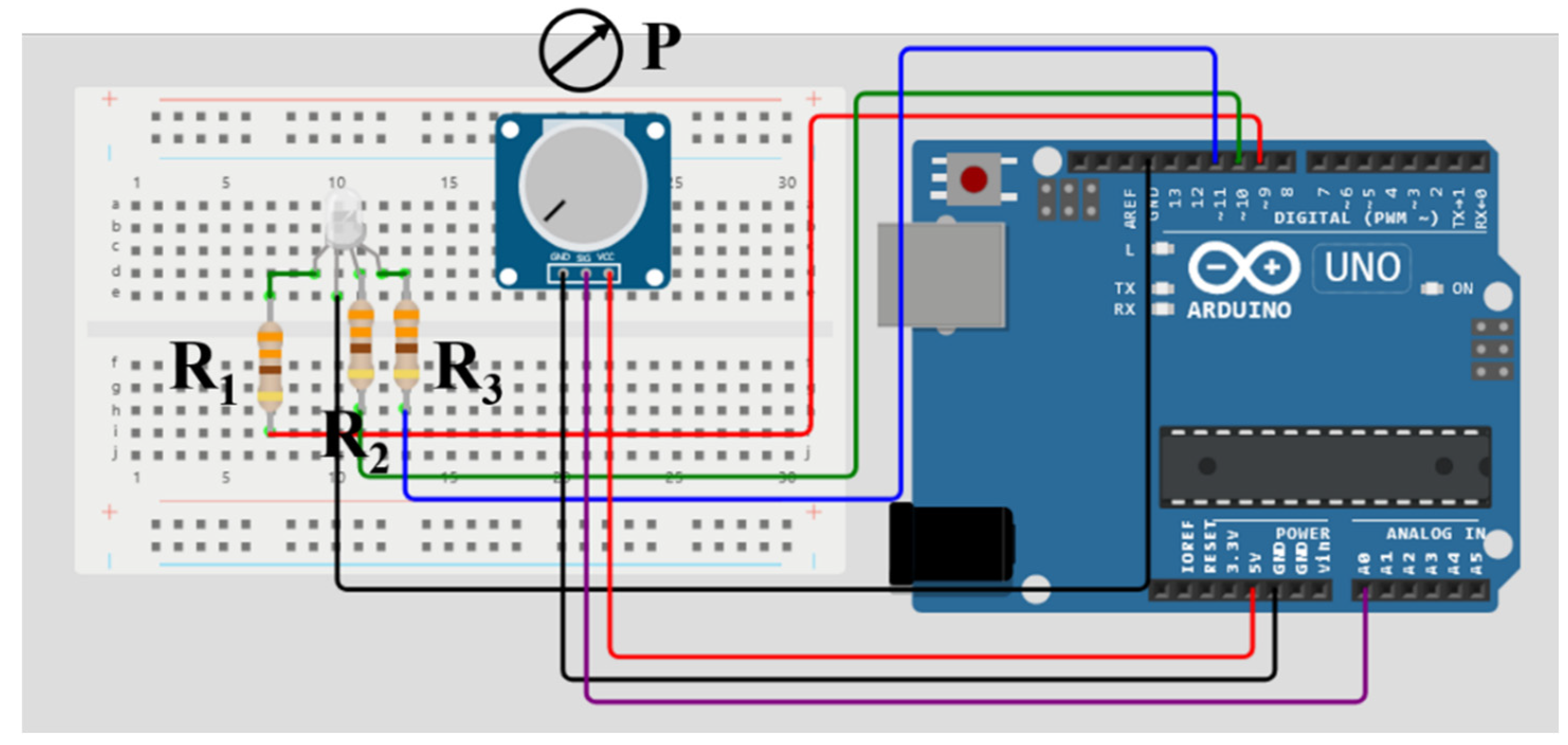
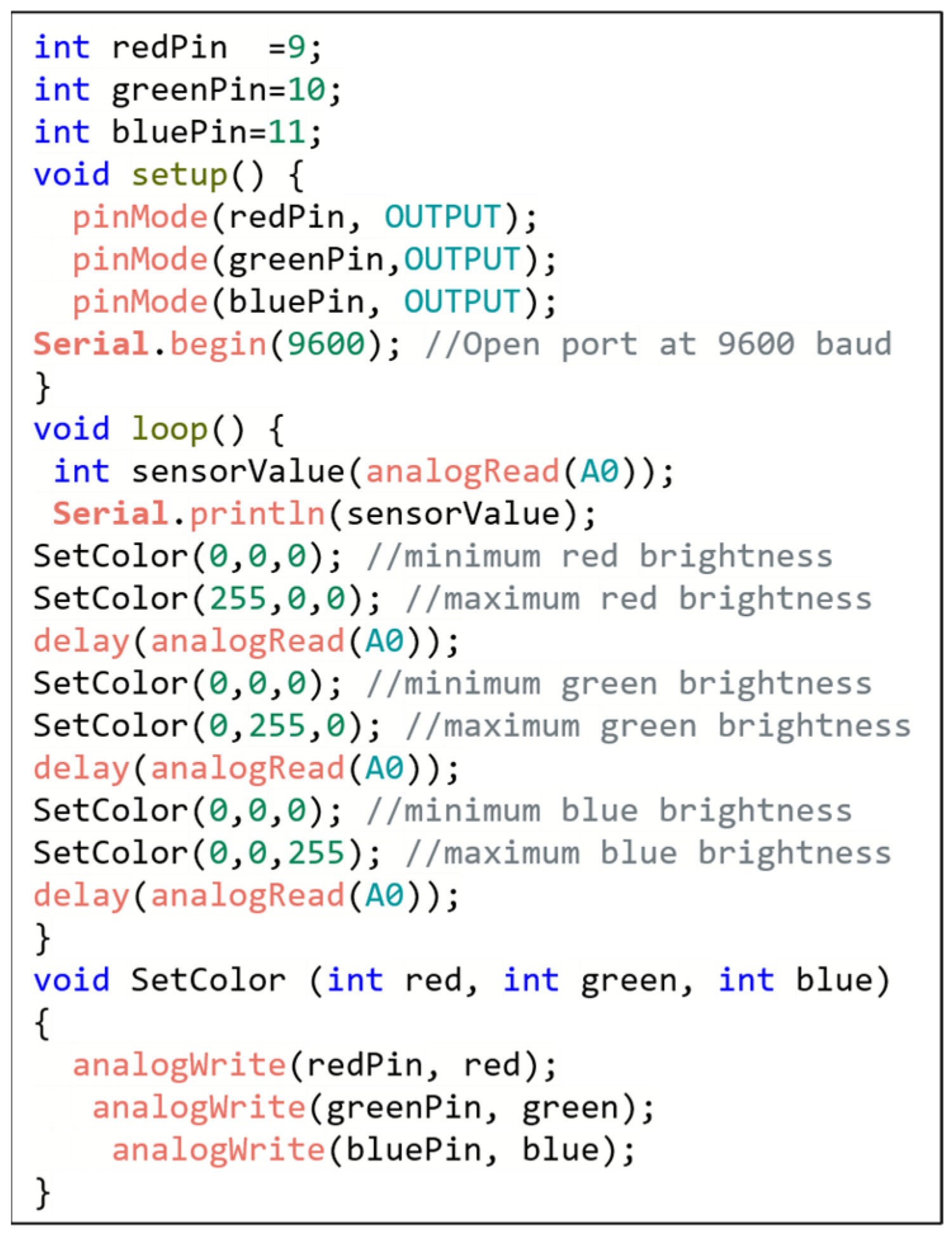
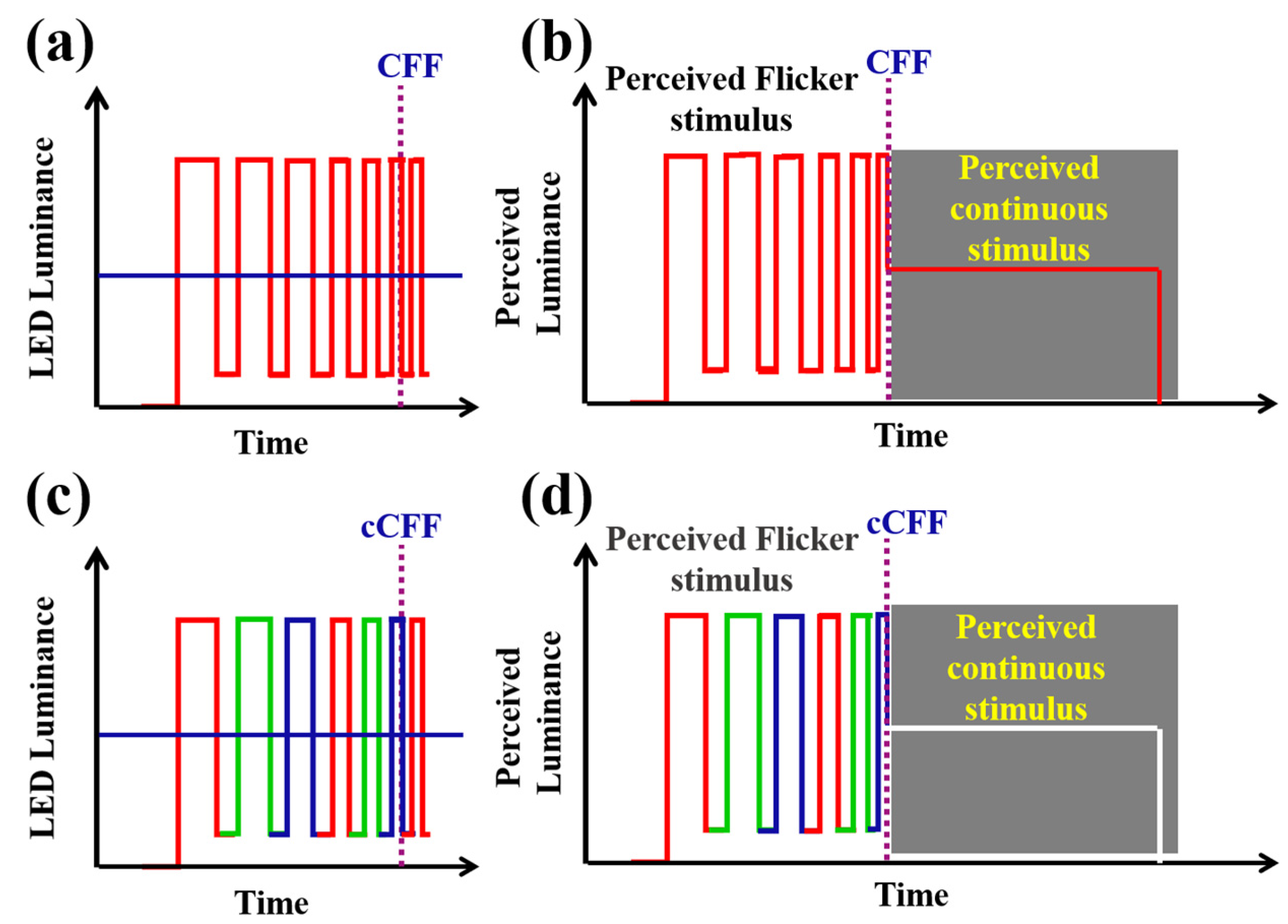
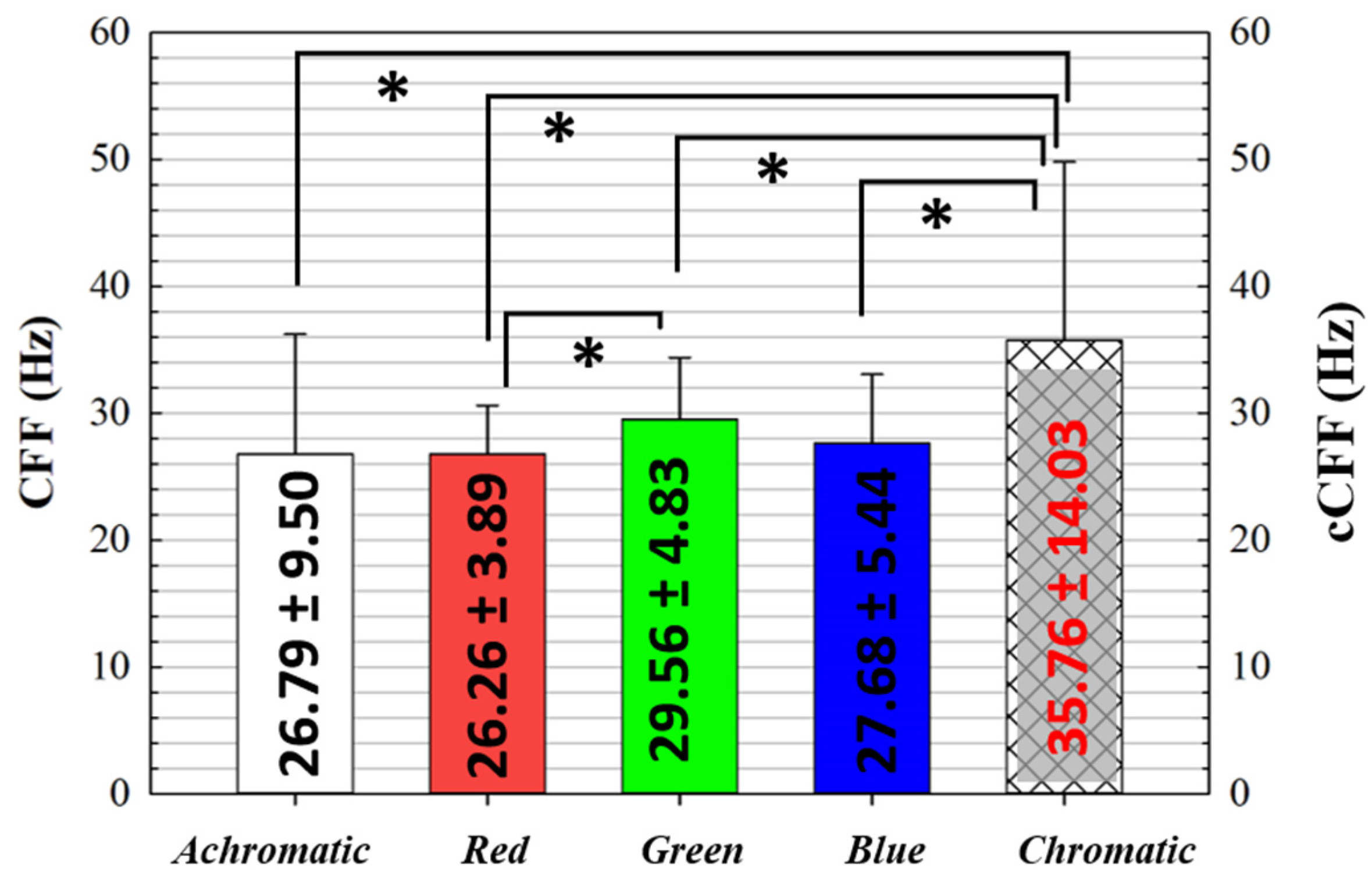
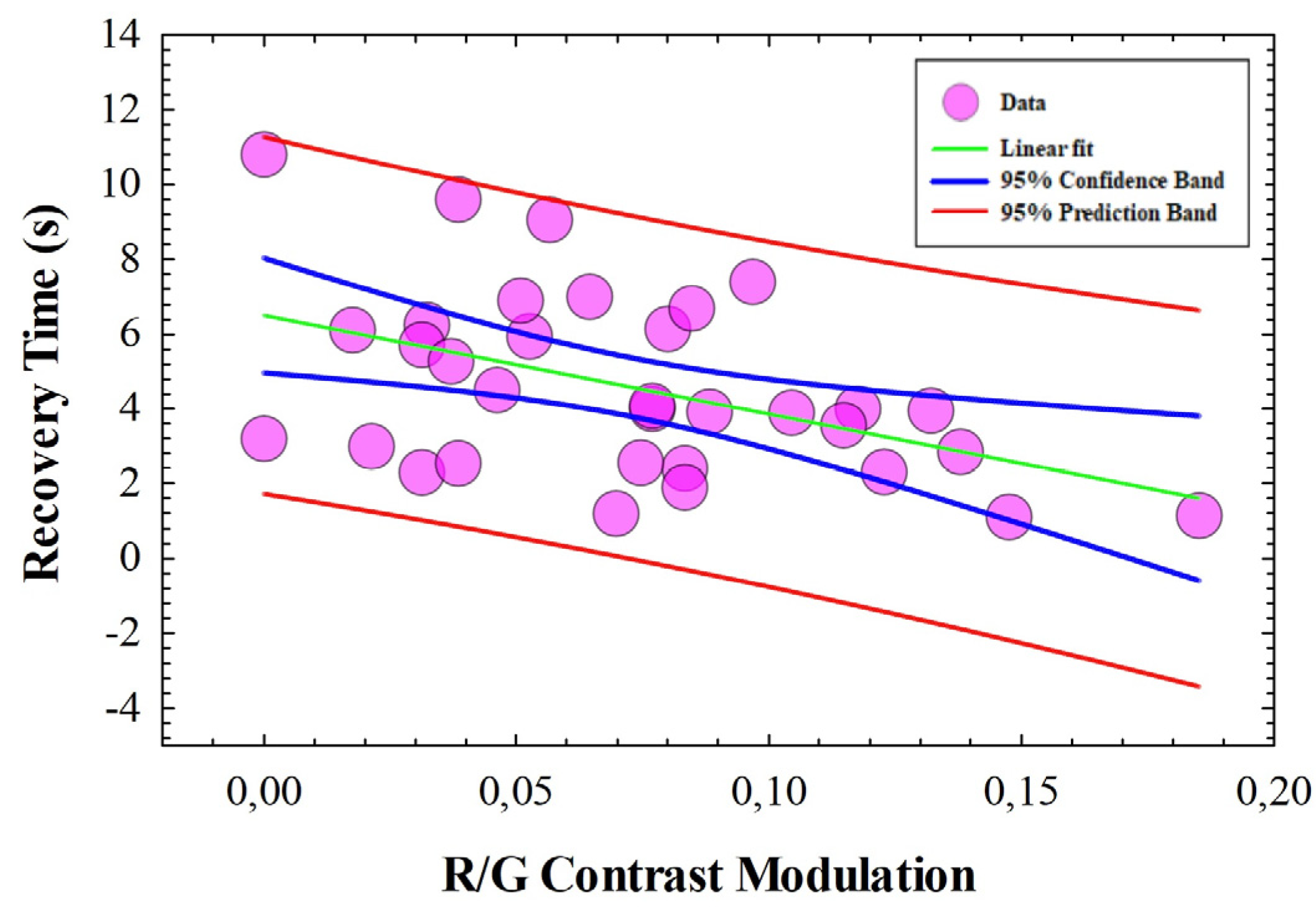
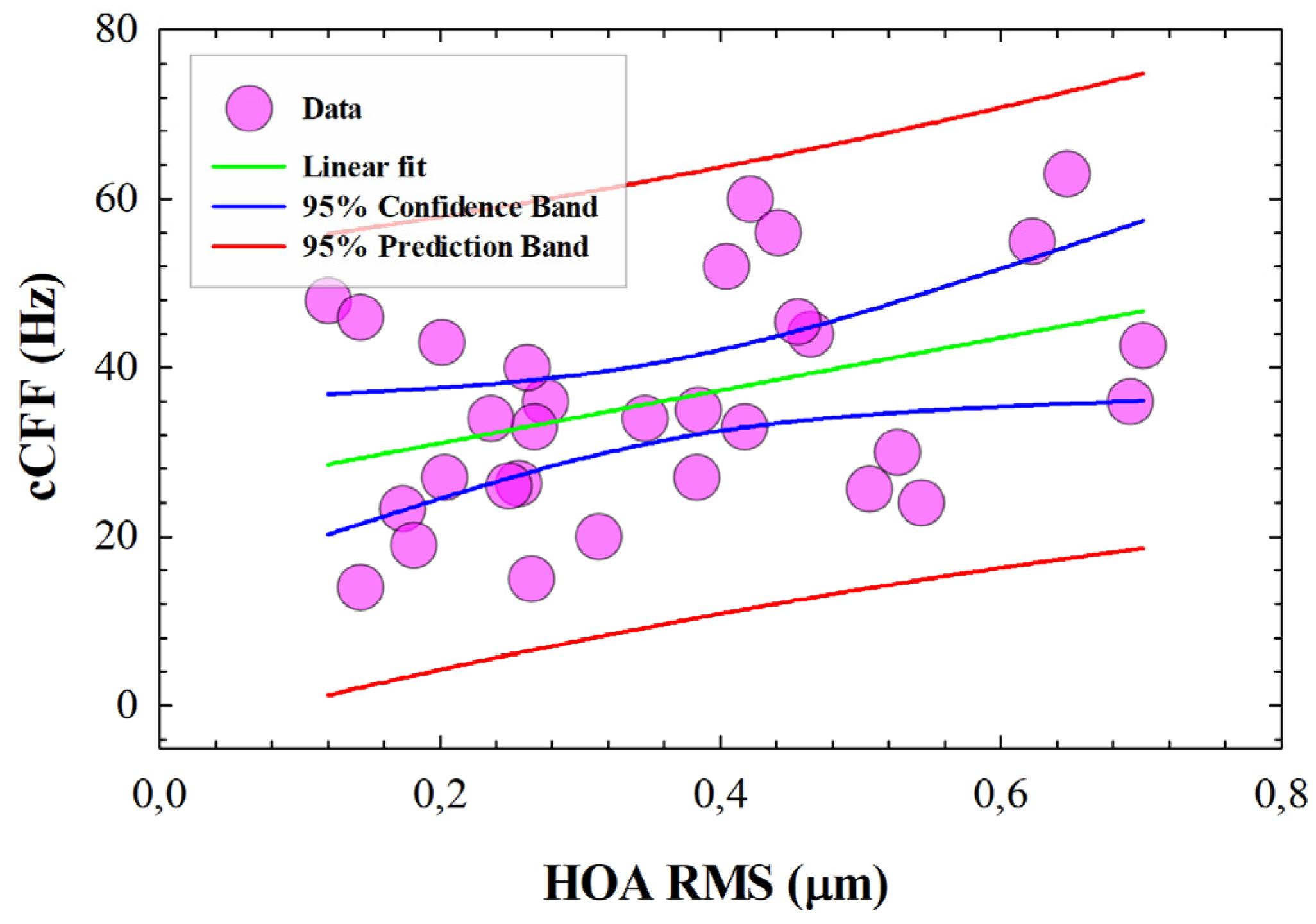
| Parameter | Measure |
|---|---|
| Luminous intensity [red] | 2600 mcd |
| Luminous intensity [green] | 2000 mcd |
| Luminous intensity [blue] | 1800 mcd |
| Distance of observation | 600 mm |
| Ambient illumination | 200 Lux |
| Eccentricity | Foveal vision |
| CFF red | CFF for red stimulus (Hz) |
| CFF green | CFF for green stimulus (Hz) |
| CFF blue | CFF for blue stimulus (Hz) |
| CFF achromatic | CFF for white light stimulus (Hz) |
| Chromatic CFF (cCFF) | CFF for mixed red, green and blue lights. |
| Achromatic | RED | GREEN | BLUE | RGB | R/G | |
| PRT | p=0.836 | p=0.812 | p=0.506 | p=0.772 | p=0.731 | p=0.008 |
| LOA RMS | HOA RMS | Coma | SA | Trefoil |
|---|---|---|---|---|
| 2.12 ± 2.52 μm | 0.36±0.17 μm | 0.21±0.14 μm | 0.10±0.07 μm | 0.18±0.11 μm |
Disclaimer/Publisher’s Note: The statements, opinions and data contained in all publications are solely those of the individual author(s) and contributor(s) and not of MDPI and/or the editor(s). MDPI and/or the editor(s) disclaim responsibility for any injury to people or property resulting from any ideas, methods, instructions or products referred to in the content. |
© 2024 by the authors. Licensee MDPI, Basel, Switzerland. This article is an open access article distributed under the terms and conditions of the Creative Commons Attribution (CC BY) license (https://creativecommons.org/licenses/by/4.0/).





